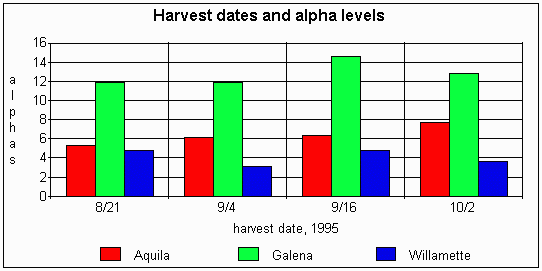 University of Vermont Extension
System
University of Vermont Extension
SystemDepartment of Plant and Soil Science
 University of Vermont Extension
System
University of Vermont Extension
SystemLeonard P. Perry, Extension Professor
Matthew H. Wood, Graduate Research Assistant
Copper Spray Timing Test (1997)
This test was conducted at the Milton hop yard on sets of three plants of the same variety, all next to each other. The purpose was to see if differences in downy mildew infection could be seen between plants sprayed with copper sulfate after a rainy period and those plants sprayed with the same copper sulfate solution on a weekly basis, regardless of the weather conditions. The third plant of the group was left unsprayed all season for comparison.
There were not many times were the "rainy period" and "weekly" copper applications differed. There was no noticeable difference in the health of the treated plants at the end of the season, but there was a dramatic difference in the health of the leaves of the treated plants compared with those of the untreated ones for the susceptible variety Aquila. Also, the cones were much healthier and less brown on the treated plants than the unsprayed ones for both Nugget and Centennial varieties.
Effect of Harvest Dates on Alpha levels (1995)
| Variety Date: | 8/21 | 9/4 | 9/16 | 10/2 |
| Aquila | 5.26 | 6.18 | 6.34 | 7.73 |
| Galena | 11.93 | 11.85 | 14.62 | 12.78 |
| Willamette | 4.80 | 3.09 | 4.74 | 3.63 |
Later the date, more browning (none on 8/21; totally brown, falling apart 10/2).

Ratings of Hops Problems in Vermont (1994)
general comments: more problems at Milton (M); main problems at Hort Res Center, So. Burlington (H): chlorosis (lack of fertility) and mites (predator timing off).
best varieties (H): Elsasser, several; (M): Eroica, Chinook
worst varieties (H): Liberty, Centennial, Backa; (M): Blue No. Brewer, Liberty, Elsasser
| Variety Problem: | A | B | C | D | E | F | G | Total | Notes |
| Aquila (H) | x | 1 | 2 | 5 | |||||
| Aquila (M) | x | x | 2 | x | 5 | 1,2 | |||
| Backa (H) | x | x | x | 2 | 5 | ||||
| Backa (M) | x | x | 3 | x | 6 | 1,3 | |||
| Banner (M) | x | x | 1 | x | 4 | ||||
| Blue No. Brewer (M) | x | x | x | x | 3 | x | x | 9 | 3 |
| Brewer's Gold (M) | 1 | x | 2 | 5 | |||||
| Bullion (M) | x | 1 | 2 | ||||||
| Cascade (H) | x | x | 0 | 2 | 5 | ||||
| Centennial (H) | x | x | 3 | 5 | 5,3 | ||||
| Chinook (H) | x | 1 | 2 | ||||||
| Chinook (M) | 2 | 2 | |||||||
| Cluster (M) | x | x | x | 2 | x | x | 7 | ||
| Elsasser (H) | 1 | 1 | 3 | ||||||
| Elsasser (M) | x | x | x | 3 | x | x | 8 | 3 | |
| Eroica (M) | 1 | 1 | 4 | ||||||
| Fuggle (H) | x | 1 | 2 | 1 | |||||
| Fuggle (M) | x | x | 2 | x | 5 | 1 | |||
| Galena (H) | x | 1 | 2 | ||||||
| Galena (M) | x | x | x | 2 | x | 6 | |||
| Liberty (H) | xx | x | 3 | 5 | 3,5 | ||||
| Liberty (M) | x | x | x | 3 | x | x | 8 | 1 | |
| Nuggett (H) | x | x | 1 | 3 | |||||
| Nuggett (M) | x | 2 | 3 | ||||||
| Perle (H) | x | 1 | 2 | 3 | |||||
| Perle (M) | x | x | x | 2 | x | x | 7 | 1,3 | |
| Saaz (H) | x | x | 2 | 4 | 1,5 | ||||
| Saaz (M) | x | x | x | 2 | x | x | 7 | 3 | |
| Tettnanger (M) | x | x | 3 | x | x | 7 | 1 | ||
| Wild (M--Westford) | x | 3 | x | 5 | 2 | ||||
| Wild (M--Green Mtn) | x | x | 2 | 4 | |||||
| Willamette (H) | x | x | 1 | 3 | 5 | ||||
| Willamette (M) | x | x | x | 2 | 5 |
Notes:1=brittle, ashen leaves, 2=mildew early in season, 3=poor vigor, 4=very late cones, 5=aphids, sooty mold. All Milton leaves were tattered from wind damage.